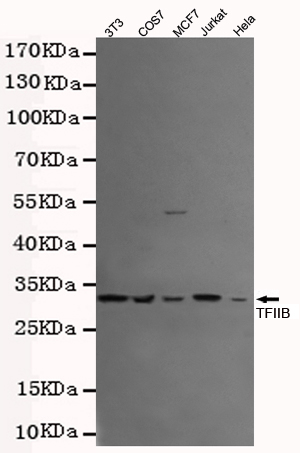TFIIB Antibody
Purified Mouse Monoclonal Antibody (Mab)
- SPECIFICATION
- CITATIONS
- PROTOCOLS
- BACKGROUND

Application
| WB |
|---|---|
| Primary Accession | Q00403 |
| Reactivity | Human, Mouse |
| Host | Mouse |
| Clonality | Monoclonal |
| Isotype | IgG2b |
| Calculated MW | 34 KDa |
| Gene ID | 2959 |
|---|---|
| Other Names | General transcription factor IIB;General transcription factor TFIIB;gtf2b;RNA polymerase II transcription factor IIB;S300 II;S300-II;TF IIB;TF2B;TF2B_HUMAN;TFIIB;Transcription initiation factor IIB. |
| Dilution | WB~~1:500 |
| Format | Liquid in PBS containing 50% glycerol, 0.5% BSA and 0.02% sodium azide, pH 7.3. |
| Storage | Store at 4°C short term. Aliquot and store at -20°C long term. Avoid freeze/thaw cycles. |
| Name | GTF2B |
|---|---|
| Synonyms | TF2B, TFIIB |
| Function | General transcription factor that plays a role in transcription initiation by RNA polymerase II (Pol II). Involved in the pre-initiation complex (PIC) formation and Pol II recruitment at promoter DNA (PubMed:12931194, PubMed:1517211, PubMed:1876184, PubMed:1946368, PubMed:27193682, PubMed:3029109, PubMed:3818643, PubMed:7601352, PubMed:8413225, PubMed:8515820, PubMed:8516311, PubMed:8516312, PubMed:9420329). Together with the TATA box-bound TBP forms the core initiation complex and provides a bridge between TBP and the Pol II-TFIIF complex (PubMed:8413225, PubMed:8504927, PubMed:8515820, PubMed:8516311, PubMed:8516312). Released from the PIC early following the onset of transcription during the initiation and elongation transition and reassociates with TBP during the next transcription cycle (PubMed:7601352). Associates with chromatin to core promoter-specific regions (PubMed:12931194, PubMed:24441171). Binds to two distinct DNA core promoter consensus sequence elements in a TBP- independent manner; these IIB-recognition elements (BREs) are localized immediately upstream (BREu), 5'-[GC][GC][GA]CGCC-3', and downstream (BREd), 5'-[GA]T[TGA][TG][GT][TG][TG]-3', of the TATA box element (PubMed:10619841, PubMed:16230532, PubMed:7675079, PubMed:9420329). Modulates transcription start site selection (PubMed:10318856). Also exhibits autoacetyltransferase activity that contributes to the activated transcription (PubMed:12931194). |
| Cellular Location | Nucleus. Chromosome. Note=Non-acetylated form colocalizes with DNA in the G0/1, S and G2 phases of the cell cycle, but not during mitosis (PubMed:24441171). Acetylated form colocalizes at transcriptionally silent mitotic chromatids during mitosis at metaphase, anaphase, and telophase phases of the cell cycle (PubMed:24441171). |
| Tissue Location | Expressed in the inner cell mass forming the embryoblast (PubMed:24441171). Not detected in cells from the outer thin layer trophoblast (at protein level) (PubMed:24441171) |

Thousands of laboratories across the world have published research that depended on the performance of antibodies from Abcepta to advance their research. Check out links to articles that cite our products in major peer-reviewed journals, organized by research category.
info@abcepta.com, and receive a free "I Love Antibodies" mug.
Provided below are standard protocols that you may find useful for product applications.
Background
General factor that plays a major role in the activation of eukaryotic genes transcribed by RNA polymerase II.
References
Ha I.,et al.Nature 352:689-695(1991).
Malik S.,et al.Proc. Natl. Acad. Sci. U.S.A. 88:9553-9557(1991).
Ota T.,et al.Nat. Genet. 36:40-45(2004).
Goshima N.,et al.Nat. Methods 5:1011-1017(2008).
Gregory S.G.,et al.Nature 441:315-321(2006).
If you have used an Abcepta product and would like to share how it has performed, please click on the "Submit Review" button and provide the requested information. Our staff will examine and post your review and contact you if needed.
If you have any additional inquiries please email technical services at tech@abcepta.com.













 Foundational characteristics of cancer include proliferation, angiogenesis, migration, evasion of apoptosis, and cellular immortality. Find key markers for these cellular processes and antibodies to detect them.
Foundational characteristics of cancer include proliferation, angiogenesis, migration, evasion of apoptosis, and cellular immortality. Find key markers for these cellular processes and antibodies to detect them. The SUMOplot™ Analysis Program predicts and scores sumoylation sites in your protein. SUMOylation is a post-translational modification involved in various cellular processes, such as nuclear-cytosolic transport, transcriptional regulation, apoptosis, protein stability, response to stress, and progression through the cell cycle.
The SUMOplot™ Analysis Program predicts and scores sumoylation sites in your protein. SUMOylation is a post-translational modification involved in various cellular processes, such as nuclear-cytosolic transport, transcriptional regulation, apoptosis, protein stability, response to stress, and progression through the cell cycle. The Autophagy Receptor Motif Plotter predicts and scores autophagy receptor binding sites in your protein. Identifying proteins connected to this pathway is critical to understanding the role of autophagy in physiological as well as pathological processes such as development, differentiation, neurodegenerative diseases, stress, infection, and cancer.
The Autophagy Receptor Motif Plotter predicts and scores autophagy receptor binding sites in your protein. Identifying proteins connected to this pathway is critical to understanding the role of autophagy in physiological as well as pathological processes such as development, differentiation, neurodegenerative diseases, stress, infection, and cancer.


